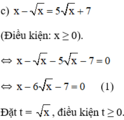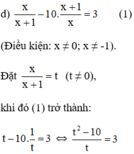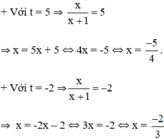Giải phương trình:
(x - 1)(x + 3) = x2 + 4
Hãy nhập câu hỏi của bạn vào đây, nếu là tài khoản VIP, bạn sẽ được ưu tiên trả lời.



⇔ ( x - 1 )( x + 2 )( 7 - 5x ) = 0

Vậy phương trình có tập nghiệm là S = { - 2; 1; 7/5 }.

1) `x^2+4-2(x-1)=(x-2)^2`
`<=>x^2+4-2x+2=x^2-4x+4`
`<=>-2x+2=-4x`
`<=>2x=-2`
`<=>x=-1`
.
2) ĐKXĐ: `x \ne \pm 3`
`(x+3)/(x-3)-(x-1)/(x+3)=(x^2+4x+6)/(x^2-9)`
`<=>(x+3)^2-(x-1)(x-3)=x^2+4x+6`
`<=>x^2+6x+9-x^2+4x-3=x^2+4x+6`
`<=>10x+6=x^2+4x+6`
`<=>x^2-6x=0`
`<=>x(x-6)=0`
`<=>x=0;x=6`
.
3) ĐKXĐ: `x \ne \pm 3`
`(3x-3)/(x^2-9) -1/(x-3 )= (x+1)/(x+3)`
`<=>(3x-3)-(x+3)=(x+1)(x-3)`
`<=> 2x-6=x^2-2x-3`
`<=>x^2-4x+3=0`
`<=>x^2-x-3x+3=0`
`<=>x(x-1)-3(x-1)=0`
`<=>(x-3)(x-1)=0`
`<=> x=3;x=1`
Vậy...

Ta có: 3 x 2 + 4(x – 1) = x - 1 2 + 3
⇔ 3 x 2 + 4x – 4 = x 2 – 2x + 1 + 3
⇔ 2 x 2 + 6x – 8 = 0 ⇔ x 2 + 3x – 4 = 0
Phương trình x 2 + 3x – 4 = 0 có hệ số a = 1, b = 3, c = -4 nên có dạng a + b + c = 0, suy ra x 1 = 1, x 2 = -4
Vậy phương trình đã cho có hai nghiệm x 1 = 1, x 2 = -4

a)
\(\left(9x^2-4\right)\left(x+1\right)=\left(3x+2\right)\left(x^2-1\right)\)
\(\Leftrightarrow\left(9x^2-4\right)\left(x+1\right)=\left(3x+2\right)\left(x+1\right)\left(x-1\right)\)
\(\Leftrightarrow\left(9x^2-4\right)\left(x+1\right)-\left(3x+2\right)\left(x+1\right)\left(x-1\right)=0\)
\(\Leftrightarrow\left(x+1\right)\left[9x^2-4-\left[\left(3x+2\right)\left(x-1\right)\right]\right]=0\)
\(\Leftrightarrow\left(x+1\right)\left[9x^2-4-\left(3x^2-3x+2x-2\right)\right]=0\)
\(\Leftrightarrow\left(x+1\right)\left(9x^2-4-3x^2+3x-2x+2\right)=0\)
\(\Leftrightarrow\left(x+1\right)\left(6x^2+x-2\right)=0\)
\(\Leftrightarrow\left[{}\begin{matrix}x+1=0\\6x^2+x-2=0\end{matrix}\right.\Leftrightarrow\left[{}\begin{matrix}x=1\\\left(2x-1\right)\left(3x+2\right)=0\end{matrix}\right.\)
\(\Leftrightarrow\left[{}\begin{matrix}x=1\\x=\dfrac{-2}{3}\\x=\dfrac{1}{2}\end{matrix}\right.\)
Vậy \(x\in\left\{1;\dfrac{-2}{3};\dfrac{1}{2}\right\}\)
b)
\(\left(x-1\right)^2-1+x^2=\left(1-x\right)\left(x+3\right)\)
\(\Leftrightarrow x^2-2x+1-1+x^2=x+3-x^2-3x\)
\(\Leftrightarrow2x^2-2x=x^2-2x+3\)
\(\Leftrightarrow3x^2=3\)
\(\Leftrightarrow x^2=1\)
\(\Leftrightarrow x=\left(\pm1\right)^2\)
\(\Leftrightarrow\left[{}\begin{matrix}x=1\\x=-1\end{matrix}\right.\)
Vậy \(x\in\left\{1;-1\right\}\)

ĐKXĐ: \(x\notin\left\{2;-2\right\}\)
Ta có: \(\dfrac{x}{x-2}+1=\dfrac{2x^2+3}{x^2-4}\)
\(\Leftrightarrow\dfrac{x\left(x+2\right)}{\left(x-2\right)\left(x+2\right)}+\dfrac{x^2-4}{\left(x-2\right)\left(x+2\right)}=\dfrac{2x^2+3}{\left(x-2\right)\left(x+2\right)}\)
Suy ra: \(x^2+2x+x^2-4=2x^2+3\)
\(\Leftrightarrow2x-4=3\)
\(\Leftrightarrow2x=7\)
\(\Leftrightarrow x=\dfrac{7}{2}\)(thỏa ĐK)
Vậy: \(S=\left\{\dfrac{7}{2}\right\}\)

\(a.\left(3x+2\right)\left(x^2-1\right)=\left(9x^2-4\right)\left(x+1\right)\)
\(\Leftrightarrow\left(3x+2\right)\left(x+1\right)\left(x-1\right)=\left(3x-2\right)\left(3x+2\right)\left(x+1\right)\)
\(\Leftrightarrow x-1=3x-2\)
\(\Leftrightarrow2x=1\)
\(\Leftrightarrow x=\dfrac{1}{2}\)
c: =>x-3=0
hay x=3
d: \(\Leftrightarrow\left(3x-1\right)\cdot\left(x^2+2-7x+10\right)=0\)
\(\Leftrightarrow\left(3x-1\right)\left(x-3\right)\left(x-4\right)=0\)
hay \(x\in\left\{\dfrac{1}{3};3;4\right\}\)

\(\left(3x+2\right)\left(x^2-1\right)=\left(9x^2-4\right)\left(x+1\right).\)
\(\Leftrightarrow\left(3x+2\right)\left(x-1\right)\left(x+1\right)-\left(3x-2\right)\left(3x+2\right)\left(x+1\right)=0.\)
\(\Leftrightarrow\left(3x+2\right)\left(x+1\right)\left(x-1-3x+2\right)=0.\)
\(\Leftrightarrow\left(3x+2\right)\left(x+1\right)\left(-2x+1\right)=0.\)
\(\Leftrightarrow\left[{}\begin{matrix}3x+2=0.\\x+1=0.\\-2x+1=0.\end{matrix}\right.\)\(\Leftrightarrow\left[{}\begin{matrix}x=-\dfrac{2}{3}.\\x=-1.\\x=\dfrac{1}{2}.\end{matrix}\right.\)
c: =>(x-3)(x2+3x+5)=0
=>x-3=0
hay x=3
d: =>(3x-1)(x2+2-7x+10)=0
=>(3x-1)(x-3)(x-4)=0
hay \(x\in\left\{\dfrac{1}{3};3;4\right\}\)

a)
3 · x 2 + x 2 - 2 x 2 + x - 1 = 0 ( 1 )
Đặt t = x 2 + x ,
Khi đó (1) trở thành : 3 t 2 – 2 t – 1 = 0 ( 2 )
Giải (2) : Có a = 3 ; b = -2 ; c = -1
⇒ a + b + c = 0
⇒ (2) có hai nghiệm t 1 = 1 ; t 2 = c / a = - 1 / 3 .
+ Với t = 1 ⇒ x 2 + x = 1 ⇔ x 2 + x – 1 = 0 ( * )
Có a = 1; b = 1; c = -1 ⇒ Δ = 1 2 – 4 . 1 . ( - 1 ) = 5 > 0
(*) có hai nghiệm


Có a = 3; b = 3; c = 1 ⇒ Δ = 3 2 – 4 . 3 . 1 = - 3 < 0
⇒ (**) vô nghiệm.
Vậy phương trình (1) có tập nghiệm 
b)
x 2 − 4 x + 2 2 + x 2 − 4 x − 4 = 0 ⇔ x 2 − 4 x + 2 2 + x 2 − 4 x + 2 − 6 = 0 ( 1 )
Đặt x 2 – 4 x + 2 = t ,
Khi đó (1) trở thành: t 2 + t – 6 = 0 ( 2 )
Giải (2): Có a = 1; b = 1; c = -6
⇒ Δ = 1 2 – 4 . 1 . ( - 6 ) = 25 > 0
⇒ (2) có hai nghiệm

+ Với t = 2 ⇒ x 2 – 4 x + 2 = 2
⇔ x 2 – 4 x = 0
⇔ x(x – 4) = 0
⇔ x = 0 hoặc x = 4.
+ Với t = -3 ⇒ x 2 – 4 x + 2 = - 3
⇔ x2 – 4x + 5 = 0 (*)
Có a = 1; b = -4; c = 5 ⇒ Δ ’ = ( - 2 ) 2 – 1 . 5 = - 1 < 0
⇒ (*) vô nghiệm.
Vậy phương trình ban đầu có tập nghiệm S = {0; 4}.

Khi đó (1) trở thành: t 2 – 6 t – 7 = 0 ( 2 )
Giải (2): Có a = 1; b = -6; c = -7
⇒ a – b + c = 0
⇒ (2) có nghiệm t 1 = - 1 ; t 2 = - c / a = 7 .
Đối chiếu điều kiện chỉ có nghiệm t = 7 thỏa mãn.
+ Với t = 7 ⇒ √x = 7 ⇔ x = 49 (thỏa mãn).
Vậy phương trình đã cho có nghiệm x = 49.

⇔ t 2 – 10 = 3 t ⇔ t 2 – 3 t – 10 = 0 ( 2 )
Giải (2): Có a = 1; b = -3; c = -10
⇒ Δ = ( - 3 ) 2 - 4 . 1 . ( - 10 ) = 49 > 0
⇒ (2) có hai nghiệm:


Cả hai nghiệm đều thỏa mãn điều kiện xác định.
Vậy phương trình đã cho có tập nghiệm 

(x – 1)4 = x2 – 2x + 3 (1)
(1) ( x − 1 ) 2 2 = x 2 − 2 x + 3 ⇔ ( x 2 − 2 x + 1 ) 2 = x 2 − 2 x + 3
Đặt t = x2 – 2x + 1, t≥0, phương trình (2) trở thành t 2 = t + 2 ⇔ t 2 − t − 2 = 0 ⇔ ( t − 2 ) ( t + 1 ) = 0
ó t = 2 (tm) hoặc t = –1 (loại)
Với t = 2 có x 2 − 2 x + 1 = 2 ⇔ x 2 − 2 x − 1 = 0 ⇔ x = 1 ± 2
Vậy tập nghiệm của phương trình (1) là 1 − 2 ; 1 + 2
\(\left(x+1\right)\left(x+3\right)=x^2+4\)
\(\Leftrightarrow x^2+4x+3=x^2+4\)
\(\Leftrightarrow x^2-x^2+4x=4-3\)
\(\Leftrightarrow4x=1\)
\(\Leftrightarrow x=\frac{1}{4}\)
\(\left(x-1\right)\left(x+3\right)=x^2+4\)
\(x^2+2x-3=x^2+4\)
\(x^2+2x-3-x^2-4=0\)
\(2x-7=0\)
\(2x=7\)
\(x=\frac{7}{2}\)